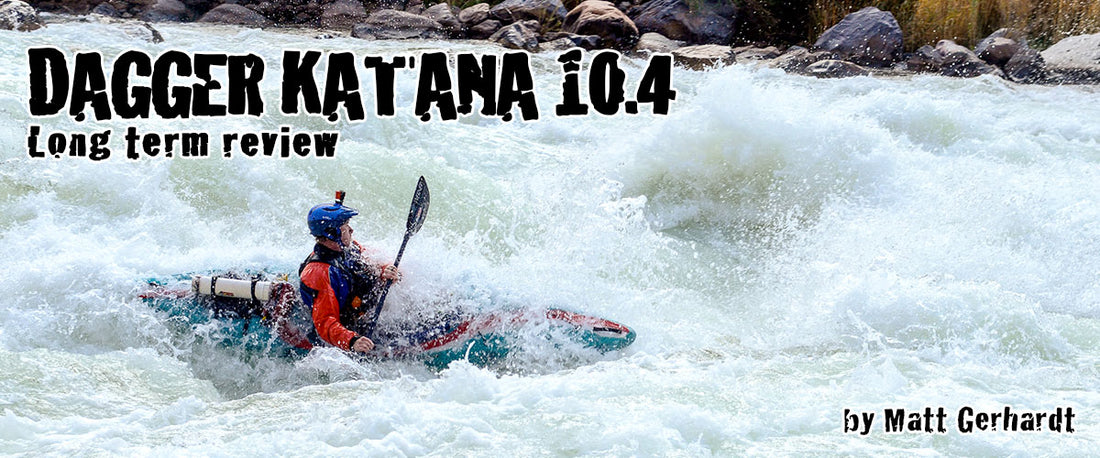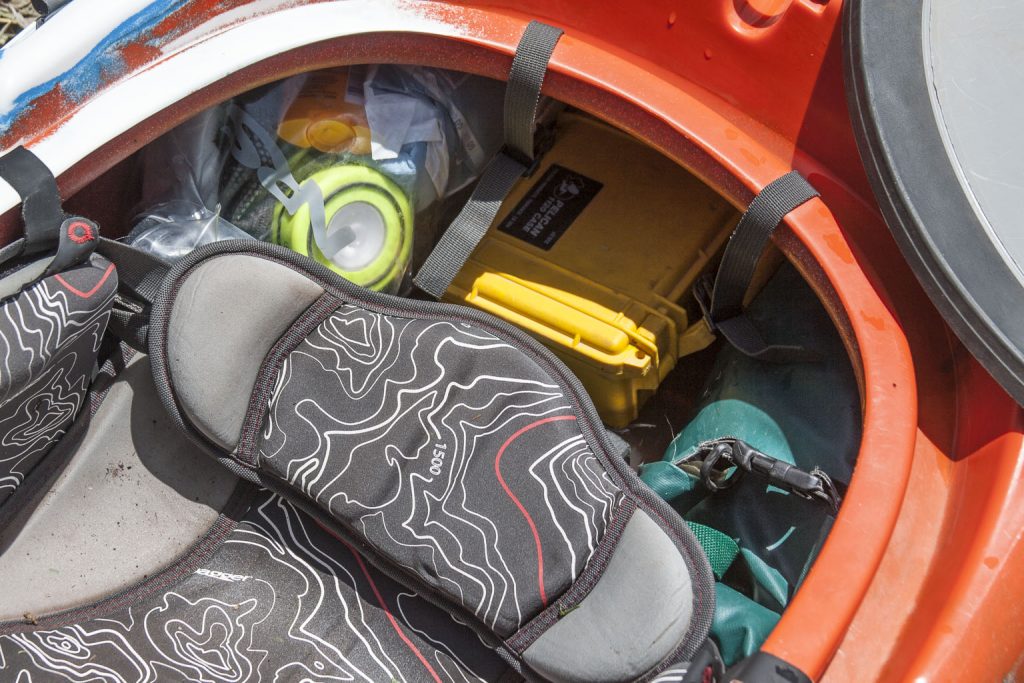
Dagger Katana 10.4 long-term review
Matt GerhardtWhitewater Expedition Kayak.
River Cross-Over.
Self-Support Assault Weapon.
The Dagger Katana 10.4 is all of these things and more. Over the past year, I’ve had the opportunity to spend the better part of 2 weeks paddling and living out the Katana, and I can honestly say it has won me over. From the ease of packing, to the stability, to the overall performance of the boat, it puts a smile on my face every time! The Katana is versatile enough to be appreciated by anyone, from rank beginners to seasoned pros, with enough stability and tracking thanks to the skeg for a total novice, but with enough agility and performance to be paddled on Class V as well. If your focus is self-support paddling, whether its on calm water stretches like the Green River, or on big, technical whitewater like Cataract Canyon, the Katana is the boat for you.

Packing the boat:
This is one area where the Katana really shines. The spacious, sealed rear hatch allows for ample and easy gear loading and access. One thing that I’ve noticed compared to other models is that the skeg and its cable are much less obtrusive, making the Katana very easy to load. I was able to fit my tent, sleeping bag, clothing, Dromedary water bag, trash bag, firepan parts (split amongst the group), miscellaneous gear bag, camp shoes, kitchen tarp and small Pelican cases inside my rear hatch with just enough room for a few beers.
Up front, the removable center column and bulkhead allows for tons of easily-accessible storage in the bow. I try to put heavier items that I won’t need to access throughout the day up front, such as my dinner/breakfast food bag, Kelty Noah’s Tarp, 64oz whiskey flask, GSI Pinnacle Dualist Complete Cookset in an NRS 10L Tuff Sack, Travel Chair Joey Chair, Jacks Plastic Water Bucket, and more beer, in front of the bulkhead. For more of the gear we used on this and other trips, see our How to Self-Support Kayak post.

In the cockpit, thanks to the ample space between the backband and the rear bulkhead, I was able to keep my lunch bag, day gear bag, small first aid and my digital SLR camera inside of a Watershed Ocoee with Liner behind the seat. I also kept my sunblock, spare sunglasses and snacks in the Katana’s integrated soft-case beam bag that sits on the center support column.
I opted to “reach across the aisle” and added the Jackson Kayak Hard Hat Hatch Cover system for added implosion protection and so I could carry my groover tube outside of my boat. The system fit and worked perfectly, but the groover tube would catch the current on some of the bigger rapids of the Grand and pushed my stern around quite a lot when it did so. Both this system and the factory hatch cover (which Jimbo used as-is) worked great with negligible leakage.
I started the trip with a deck bag lashed to the deck bungees to contain my map, but found it more trouble than it was worth and interfered with my paddling in the whitewater. So I stashed it in my hatch and tucked the map between my seat and the sidewall, which was just as convenient.
*Note on use: Make sure not to lose the bulkhead mount nuts or the center column bolt. We carried spares just in case. You will be taking these on and off every day of a multi-day trip and they are easy to misplace. I got in the habit of threading them back onto the bolts and threading the column bolt back into the inserts to keep the sand out and to keep from losing it. Be careful not to tweak this bolt when loading or unloading if you do so. *

Fit and comfort:
I haven’t found an outfitting system on the market that fits me better than Dagger’s Contour Ergo System, and the Katana is no exception. The thigh-brace profile, leg lifter, easy to adjust hip pads and ratchet back band work in conjunction for a precise and comfortable fit. I found that by tightening the upper retainer straps that attach to the back of the backband, I could pull it up high on my back and provide amazing lumbar support for all the flatwater sections. The Katana was comfortable enough where I could paddle for the better part of 6 hours without having to get out of the boat to stretch.
My one gripe with the Katana is the leaking. Granted, it is a Dagger, which have never had the reputation of being super dry kayaks, but deck bungee mounts definitely don’t help things. For some reason, Dagger decided to use a molded-in nut on the very front bungee mount, but none of the others. That means there are 21 holes total in the front of the rear bulkhead if you count all the outfitting mounts, the cockpit and the drain plug. This was totally manageable with a good bilge sponge and some pre-trip duct taping, but I was spending a bit more time sponging compared to the other kayaks on the trip.

Paddling Performance:
No gripes in this arena, the Katana simply paddles great. If you’ve ever paddled a Dagger Mamba, this boat will feel remarkably familiar. The first thing you’ll notice is the stability, especially when fully loaded. Going for a practice roll, you actually have a hard time tipping it completely upside down. But the cool part is when you realize that this boat REALLY doesn’t want to be upside down. It rolls AMAZINGLY easily, despite mine weighing in at over 160lbs with all my gear. Bracing was super easy in the Katana, with a forgiving, rounded chine that snapped back into place when you need it to. All this makes the Katana very confidence inspiring, especially in big water.
With all the flatwater on the Grand, I was very happy to have the drop-skeg, which keeps the boat tracking straight and allows for more time to enjoy the scenery instead of where you’re going. With the skeg up, the bow wants to wander without quite a lot of correction, and this holds true in whitewater to some extent as well. With all of the funky currents of the 40,000 cfs High Flow Experiment on the Grand, we found ourselves leaving the skeg down even in the rapids, which would help keep things on line in the pushy current and would help us cruise through the large boils and whirlpools at the bottom of the drops. Even on the lower water rivers of the Salt and the Dolores, I would leave the skeg at least part way down, even on the more technical rapids. For overly shallow or technical rapids, I fully retracted the skeg and the Katana would pivot on a dime.
Boofing any fully loaded boat is not an easy task, and the Katana is no exception. Even still, I was able to keep the bow from subbing out on steep rapids like Snaggletooth on the Dolores and Black Rock on the Salt, with the right timing and enough power. In big water, we were punching holes and laterals that would have eaten us alive in lighter weight boats. It was really fun pointing it for the biggest hole you could find and running hey-diddle-diddle-right-down-the-middle with some speed. And while paddling such a heavy boat does take some getting used to at first, the Katana’s predictability makes it so that any semi-competent paddler will have it figured out in no time!

Conclusion:
There are few boats in my paddling career that I’ve been as excited to paddle as the Katana. Granted, a portion of that is the types of trips it is designed for, which are the types of trips that I REALLY enjoy doing, but a good chunk of that is the boat itself. Every time that I paddle the Katana on a self-support mission, I know I’m making long-lasting memories and am bound to have a good time. And while I could be doing that in just about ANY boat that is large enough to pack all my gear in, the Katana makes it pleasurable, thanks to its ease of packing, comfort, and overall performance.
- Stable & forgiving without being sluggish. Very versatile.
- Ease of packing thanks to the hatch & bulkhead system.
- Most comfortable outfitting on the market.
- Drop Skeg for flatter / swirlier sections.
- Leaky hull design (it’s a Dagger!)
- Easy to lose bulkhead nuts
- Protruding screws in the bow are easy to tear a drybag on.

Two Katana’s in Crystal Rapid at almost 40,000 c.f.s. This was our very first rapid of the high-water flow event, and I found myself upside down thanks to shaky nerves and my groover tube getting buried in the trough of the biggest wave. Luckily, the Katana doesn’t like to be upside down when fully loaded and was a (slow) breeze to roll.
